“a ‘visual fire’ burns between our eyes and that which they behold”
-Maggie Nelson/Plato, Bluets
Is a curator a space maker? Or does she take space away? This is a question I asked myself during the curatorial process of the SAIC MFA Show 2016. The question arose after biking past a sign of a demolition company on Halsted and Lake that said “We Make Space” during the preparatory stages of the show last Fall. And however logical these three words sound they struck me as odd, because when you make space by taking down a building you also take away that space. Or perhaps a more neutral observation would be: the space is replaced.
The strong presence of space and its simultaneous physical absence due to its immaterial and unperceivable nature continuously influenced the forming of the MFA Show, and made apparent different understandings of the space by artists, curators, and gallery staff. As such, part of curating the MFA show became administrating space.
This post is not an attempt to give definitions of curating and space, but functions more as a set of reflections on the fluidity of those terms in the context of the MFA Show, and a response to several works and the collaborative experience in negotiating both.
Just like there is not one way to view an exhibition, there is not one way to curate an exhibition. I agree with Zeenat Nagree when she writes in her post that as “there are many modes of viewing the MFA Show, there are many curatorial statements to be written” and that part of that writing is in the hands of the viewer. Such perspectives are not only determined by a critic who views and writes about the show, but by anyone that moves through the exhibition–and as such activates, disrupts, or adds to the show by tracing their own path through it.
Thus, I would like to add that viewing is an exercise of moving also, or perhaps writing is an act of moving, or moving of writing. Of writing one’s body and perception in a space.
I am aware that the word “space” has been over- and understated in many curatorial statements, and in writing about it here I probably also under- and overstate it. Yet, my intention is not to look into its concept and theory, but to take space literally, perhaps as that “visual fire” that burns between us and what we see, as a presence that we all, the artist, the viewer, and the curator carve and how that manifests in an exhibition with 119 artists. Following these introductory thoughts above and Nagree’s invitation to write one of infinite curatorial statements I will write below “proposition 4 of infinite.”
Preposition 4 of infinite
Title: Re-spacing
Artists: Allyson Packer, April Martin. Anna Orlikowska, Vanessa Dion Fletcher
Is space measurable? It is difficult to take distance. We divided space [Sullivan Galleries] to create more space. What does it mean to possess space (outside your own body)?
As not all of the artists discussed in the paragraphs below are shown in proximity to each other, this proposition is perhaps a path within the existing exhibition, which I moved through in my mind while writing this, while revisiting my memories of the developments of the woks of these artists.
Allyson Packer’s work is often concerned with the site where it is located and how the audience can be a part of that site. Her artist statement starts with the following: “When we participate in an artwork, we participate in the production of a new space in the world. In my work, I harness this phenomenon. I make spaces that are performed.” As viewers, we participate in an artwork, and in the case of Packer’s work we participate in replacing and imagining a mountain from the larger Chicago area in the galleries. Packer has created a mountaintop based on a mountain that exists elsewhere, but that has the same elevation as the Sullivan Galleries’ 7th floor. Two perspectives in which this manifests: 1) in the galleries there is a small grass hill, and/or 2) there is the mountain top sticking out just above the gallery floor. We’re invited to walk on the mound, to lie on it close to the floor yet also high above the ground. In a way, Packer’s work comprises of immaterial space, but it manifests in different physical iterations of her understandings of that space in the location she is working in.
April Martin’s work in the MFA Show examines time and movement, or time as movement, or movement as time. In front of the southwest windows of the gallery, Martin has installed a set of 9 by 3 feet window blinds that she made from copper and titled The sun had not yet risen. The title is taken from Virginia Woolf’s The Waves and indicates a starting point for the work as well as for the viewers’ experience. The blinds, stacked at the bottom, have not yet completely been pulled up (or risen). And the moment that the sunlight hits them they mark the space creating a red wash of light and waves of shadows on the wall and floor surrounding the work –it is the moment the sun rises in the space. The work thus creates a conversation between outside and inside the gallery, between nature and culture among which Martin navigates. This navigation is literally manifested in another work: The sea is indistinguishable from the sky –a mobile cyanotype photolab that Martin moves back and forth between the galleries and her studio. Through the movement of the walking she creates blue waves on paper which she invites you to come see in her studio, a formative space for MFA students yet which is often closed off from the audience.
Anna Orlikowska’s work is often a reaction to and an activation of the space in which it is exhibited. These reactions and activations take the form of subtle gestures that use the walls, ceilings, pipes, or air conditioners of the space to create slight interventions that change the sound or standard use of that space. In case of the Orlikowska’s MFA Show space –which contains a video, a sounds installation, three metal standards, and a wooden object– is also the site where the video was rehearsed and made, and where the sound recorded using those same metal and wooden objects. This space between us is the overall title of the installation, and can be interpreted in multiple ways. The wooden horn-shaped object, which is based on old hearing and communication aids used on ships, lies on the floor in the room that we stand in, but can also be carried, placed on the standards, and sung through in the video projected on a wooden screen next to it; it represents the idea of a carved out space that amplifies sounds between people, between places. Alternately, or supplementary, one can see the installation as a layering of itself as well. Each individual component of the work carries its own title yet all are titled This space between us distinguished only by their material and mentioned in brackets behind the title. As a viewer, we move among the space filled with objects, through the rehearsal space for this performance and with the sound playing behind the screen.
The space Vanessa Dion Fletcher shows her work in is intimate. Although a hazardous material sign next to the entrance might seem uninviting at first, its hot pink color welcomes, and a glance inside shows the ambiance of a living room. Yet, upon entering, one in fact encounters a waiting room that leads to an examination room. Fletcher’s performance and installation, Visualize Your Cervix, is a work in which the artist invites you to look at your own cervix, a space inside one’s body. But everyone –with or without a cervix– can make an appointment to look at their bodies and thereby question (with the artist) the boundaries of their body and how those are defined by and conveyed through language and cultures. Like our bodies, the space Fletcher has created is complex, made both comfortable and uncomfortable, pointing to the contradictory standards by which bodies and histories are defined. The walls are painted red matching the color of Fletcher’s menstrual blood while a Victorian couch titled Colonial Settee is painted with blood and has porcupine quails sticking out from its back.
The work of these artists are four examples of different ways to think about space both within their work as well as in the gallery space. This multifaceted awareness of space does not define the term, but, instead, perhaps provides a few of infinite understandings of space. Space is not a unifying theme of the MFA show, but something that all artists, viewers and curators, has to deal with and talk about during this enriching process. Thank you.


